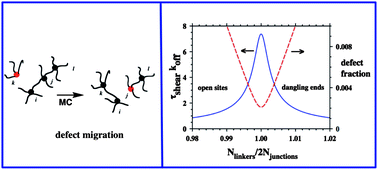The long-time reorganization of peptide networks formed by mixing “junction” and “linker” components, where the junctions contain multiple high-affinity, high-specificity binding sites for divalent “linkers”, is investigated using a mesoscale simulation model. An interesting feature of this type of system is that the concentration of defects can be controlled experimentally by varying the ratio of junction and linker concentrations in the system. In this study we use a simple simulation model to evaluate how the migration of defects controls the rate of relaxation of shear stress, and how this rate is related to junction multiplicity, defect concentration, and linker stiffness. The mean stress relaxation per defect migration event obtained through simulation was two to three times greater than assumed by standard simple theories. The results are used to develop a phenomenological theory to predict the dependence of shear viscosity on the equilibrium constant and rate constants associated with linker-junction binding, stoichiometric mismatch, and network topology. The shear stress relaxation time and viscosity are predicted to fall away sharply when junction and linker concentrations are mismatched by even 1%. Furthermore, the time-dependence of viscosity during gel “aging” is modeled as an approach to equilibrium through diffusion-limited recombination of complementary defects.
